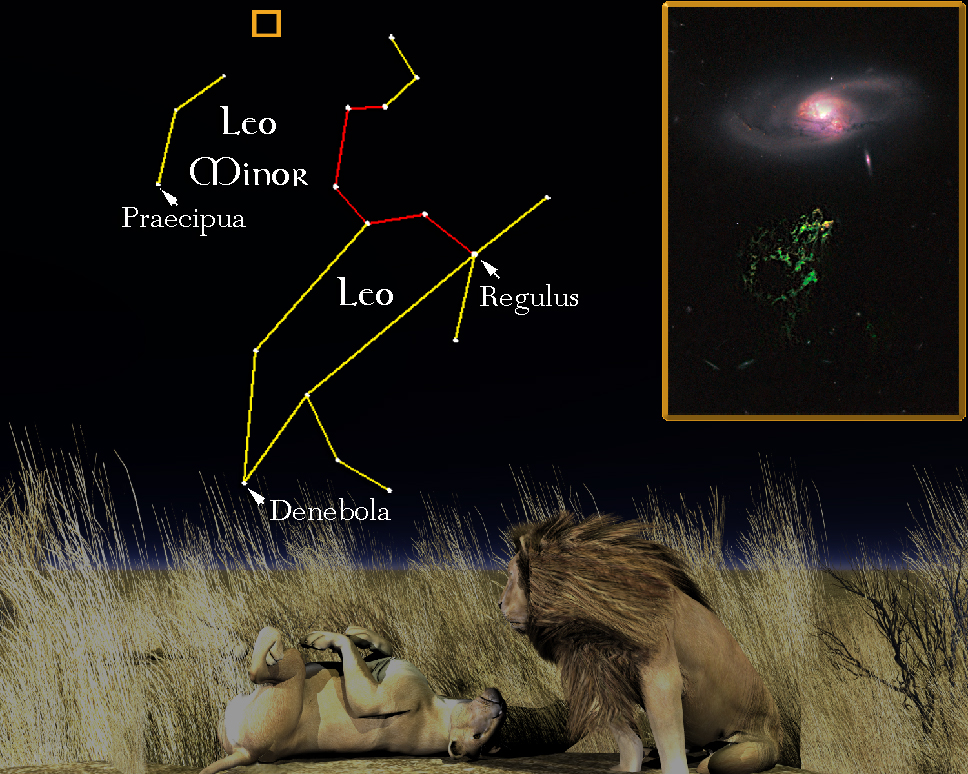
For the week including February 18, 2011

THE OTHER LION
I’ve received an inquiry from Kim, a third-grader in Sommerville, MA. She’s learning the constellations in her science class and her teacher has asked her how many snakes there are among the stars. Well, Kim, there are three among the constellations: Hydra, the Female Water Snake, and Hydrus, the Male Water Snake, are the easiest to remember. The trickiest is the constellation of Serpens, the Snake. That’s the snake that’s held in the arms of Ophiuchus in the constellation of Ophiuchus, the Serpent Bearer.
This is actually the kind of question that gets traded around the campfire at late night observing sessions among astronomers. From science to sports, whenever people with a shared interest get together there’s bound to be a fair amount of friendly knowledge competition. Baseball fans pose questions like, “What do the Dodgers dodge?” Astronomer’s trivia is more like “What are the modern constellations?” (Meaning, which ones are less than five hundred years old.)
There are eighty-eight constellations and many of them can be grouped into familiar categories:
People |
Birds |
Fish |
|
Andromeda, the Chained Maiden |
Aquila, the Eagle |
Dorado, the Dolphinfish |
|
Aquarius, the Water Carrier |
Columba, the Dove |
Pisces, the Fish |
|
Auriga, the Charioteer |
Corvus, the Crow |
Piscis Austrinus, the Southern Fish |
|
Boötes, the Herdsman |
Cygnus, the Swan |
Volans, the Flying Fish |
|
Cassiopeia, the Queen |
Grus, the Crane |
Cats |
|
Cepheus, the King |
Pavo, the Peacock |
Leo, the Lion |
|
Gemini, the Twins |
Phoenix |
Leo Minor, the Lesser Lion |
|
Hercules |
Tucana, the Toucan |
Lynx |
|
Indus, the American Indian |
Snakes |
Dogs |
|
Ophiuchus, the Serpent Bearer |
Hydra |
Canes Venatici, the Hunting Dogs |
|
Orion, the Hunter |
Hydrus |
Canis Major, the Big Dog |
|
Perseus |
Serpens |
Canis Minor, the Lesser Dog |
|
Virgo, the Maiden |
Centaurs |
Bears |
|
Flying Horses |
Centaurus, the Centaur |
Ursa Major, the Big Bear |
|
Equuleus, the Little Horse |
Sagittarius, the Archer |
Ursa Minor, the Lesser Bear |
|
Pegasus |
|
||
In our previous Night Skies we took a look at Leo, the Lion. This week we’ll take at Leo Minor, the Lesser Lion.
Thousands of years ago, ancient Egyptian astronomical charts show that they had taken some dim stars near Leo, the Lion’s, head and made a star group called the Scarab. But, because dung beetles weren’t too popular anywhere else in the world, their constellation never caught on. In the early 1680s Johannes Hevelius noticed these stars sitting around, doing nothing, and so he fashioned them into the constellation of Leo Minor, the Lesser Lion. Astronomers liked the little lion and it was quickly accepted among the modern constellations. Amateur stargazers learn this constellation very easily. Although it’s often overlooked because Leo Minor isn’t very bright, the constellation’s closeness to the stars of the Sickle (highlighted in red) makes it stand out a bit.
The Hubble Space Telescope photograph at upper right in our illustration shows the galaxy IC 2497 and the “Object” in Leo Minor . In 2007 Hanny van Arkel of the Netherlands was taking part in the Galaxy Zoo project. He was classifying the structure of IC 2497 when he noticed a strange thing beneath it. Now called Hanny’s Voorwerp (Hanny’s Object), this weird glowing cloud of gases is producing new stars in its bright patches. But nobody is quite sure as to where it came from or how it’s doing what it’s doing. The bright green color of the gas may hold a clue though. The gas is glowing the green of ionized oxygen, the same green we see in the ionized oxygen of an aurora borealis. Current thinking suggests that, inside the gases, a highly energetic star called a quasar turned on and emitted radiation that excited the oxygen causing it to fluoresce. Before burning out, the quasar blew a dark round hole in the gas visible at the object’s lower left. At any rate, the answers to the mystery may take a while to figure out, but the Lesser Lion will be getting a lot more attention in the meantime.
Oh, and as most of you instinctively knew, the Dodgers dodge trolleys.
Unless otherwise indicated, all content of this web site is the copyright of Robert Deegan and all rights are reserved.
For more information, or to comment, please contact: Bob@NightSkies.org